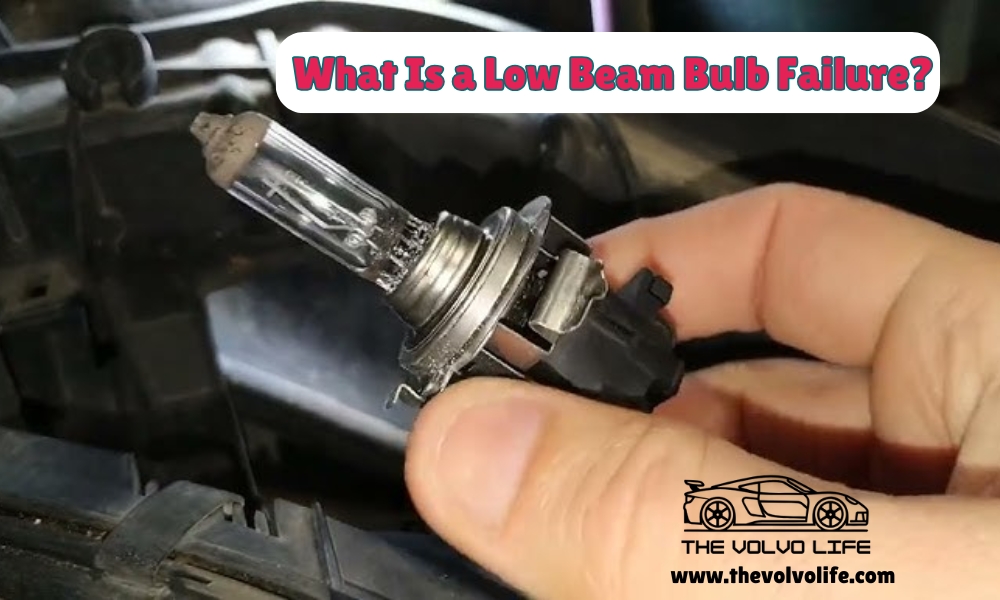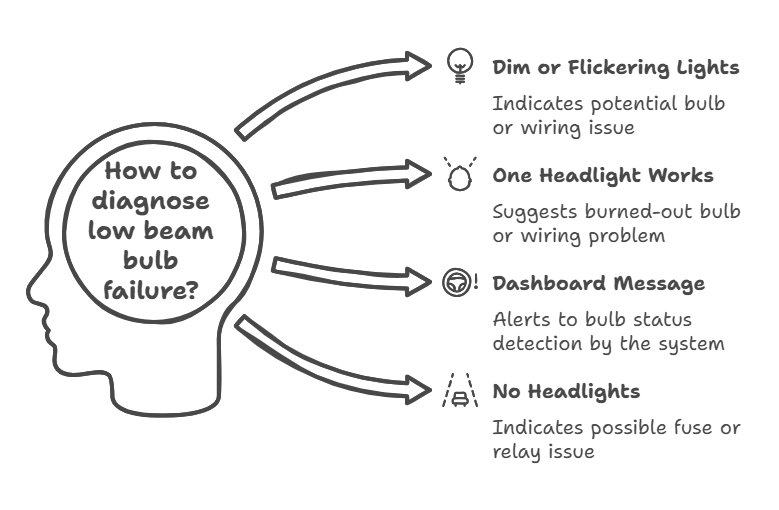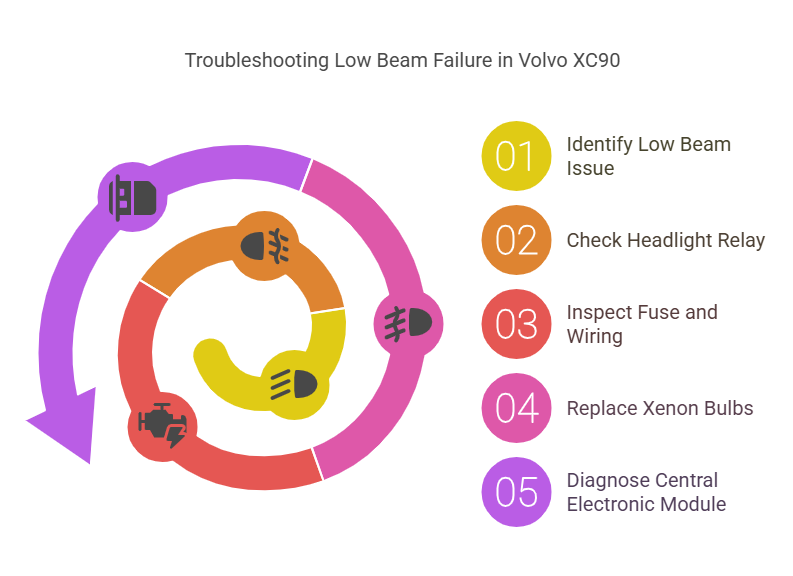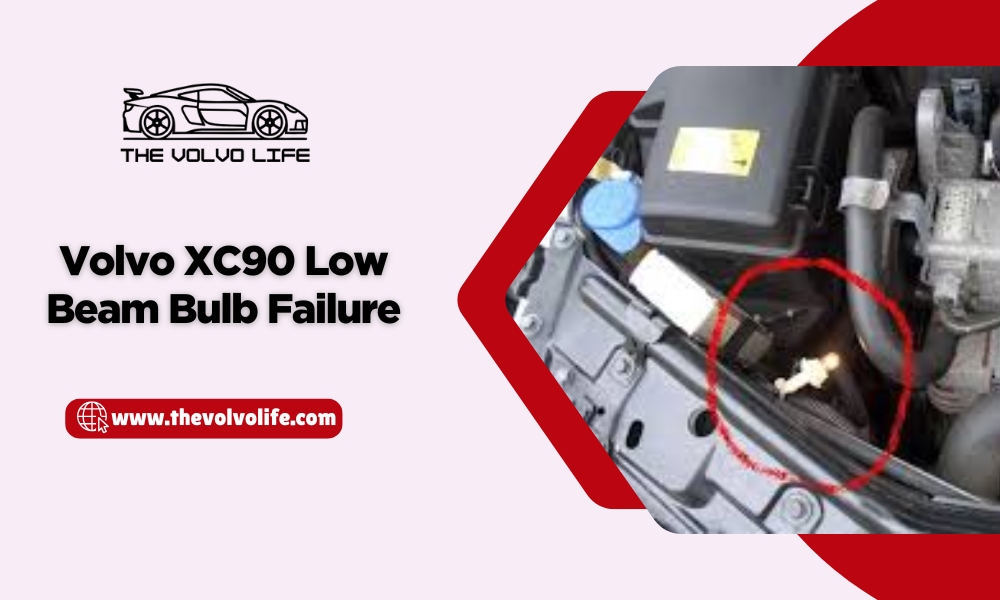Your Volvo XC90 Low Beam Bulb Failure? I’ve been in your shoes—staring into the dark, unsure what’s gone wrong. Let’s fix it together, step by step.
If you’re driving your Volvo XC90 and suddenly notice the low beam headlights not working, it can be both frustrating and dangerous. I’ve been there—and I know how nerve-wracking it is to lose visibility, especially at night or in bad weather. A working low beam isn’t just about convenience—it’s a major part of your safety.
The problem may seem simple on the surface, but low beam failure in the Volvo XC90 can come from several hidden issues. It could be a blown fuse, a bad relay, corroded wiring, or even a failing Xenon bulb. Sometimes, the issue is deep inside the car’s electrical brain—the CEM module.
That’s why I put together this guide. I’ll walk you through every possible cause and fix, step by step. Whether your Volvo XC90 headlight is not working at all or just acting up from time to time, I’ll help you figure out what’s wrong and how to fix it—without overcomplicating things.
Let’s dive into this XC90 low beam issue and get your headlights back in action.
What Is a Low Beam Bulb Failure?
Low beam lights help you see when it is dark. They shine in front of your car. This helps you drive safely at night. It also helps when it’s foggy or raining hard.
If you see “Bulb Failure Low Beam” on your car screen, it means a light bulb is not working. It’s like a light in your house that has turned off. Most of the time, the bulb is just old. It has stopped working.
Sometimes, the problem is not just the bulb. It could be a wire or something else. But usually, it’s just the bulb.
Volvo cars have lights to keep you safe. They have low beams and other lights too. 1 If a low beam bulb stops working, the car will tell you. This helps you fix it fast. Then your car will be safe to drive again

What Causes the Low Beam Bulb to Fail in a Volvo XC90?
When my low beam went out the first time, I thought, “Okay, probably just the bulb.” But after swapping it, the warning light stayed on. That’s when I realized—there’s more than one reason this could happen. Let me walk you through the common causes I’ve seen (and fixed) in Volvo XC90s over the years.
Burned-Out Halogen or HID Bulbs
This is the most common issue. If you drive an older XC90—say, a 2007, 2012, or 2013 model—you’re likely using halogen bulbs, and they don’t last forever. These bulbs can burn out over time, especially if you do a lot of night driving.
If your XC90 is newer, like a 2016 or 2017, you may have HID (High-Intensity Discharge) bulbs. They last longer but can fail suddenly without much warning. And replacing them can be pricey.
Tip: Always check both sides. If one bulb is out, the other might be close to failing too.
Faulty Wiring Harness
This one’s sneaky. I once had a case where the bulb was perfectly fine, but the wire feeding power to it was worn out. The insulation can crack with heat and age, especially near the bulb where it gets hot.
When that happens, your car might show a “Bulb Failure Low Beam” warning—even though the bulb still works when tested outside the socket.
Damaged Bulb Socket
The socket is where the bulb plugs in. I’ve seen these melt slightly over time, especially if moisture sneaks in or the bulb gets too hot.
If your bulb seems loose, flickers, or stops working when you hit a bump, the socket might be the problem.
Headlight Control Module Issues
Now this one gets a bit more high-tech. Newer Volvo XC90s, especially the ones from 2014 onward, use a control module to manage lighting.
If this tiny computer starts acting up, it can cut power to the bulb—even if everything else looks fine.
You might also notice other strange behavior, like auto lights not turning on, or both low beams flickering.
Blown Fuse or Relay Failure
Every light in your car is protected by a fuse. If the fuse blows, the light dies instantly. It’s like flipping a breaker at home. Super simple fix—if you can find the right one.
Sometimes the relay that controls the headlight circuit can fail too. It’s less common, but I’ve seen it cause headaches in the 2012 and 2016 XC90 models.
Moisture in the Headlight Assembly
This one’s more common than people think. If your headlight lens isn’t sealed right, moisture gets inside. That leads to:
- Foggy headlight glass
- Rusty bulb contacts
- Electrical shorts
I had to replace an entire headlight unit once just because water kept sneaking in during the rainy season. Not fun—or cheap.
Common Symptoms of Volvo XC90 Low Beam Bulb Failure
I still remember the first time my XC90 low beam started acting up. At first, I thought it was just my eyes playing tricks on me. But as the sun went down, the road ahead looked darker than usual—and that’s when I realized something was wrong.
If you’re dealing with Volvo XC90 headlight issues, here are the signs I’ve seen (and many other owners have, too):
1. Dim or Flickering Lights
This is usually the first clue. One of your headlights might look weaker or flicker while driving, especially on bumpy roads. It’s easy to miss if you’re not paying close attention, but it’s a strong hint something’s off with your XC90 bulb.
2. Only One Headlight Works
If one side is out while the other works fine, it could be a burned-out bulb, a wiring issue, or even a failing ballast if you’re using HID lights. I’ve had to deal with this exact issue—and trust me, it’s not always the bulb itself.
3. “Low Beam Bulb Failure” Dashboard Message
This message might pop up on your screen while driving. It’s part of Volvo’s clever system that checks bulb status. This XC90 low beam dash alert usually means the car thinks one of your bulbs isn’t working right—even if it looks fine for now.
4. Headlights Not Turning On at All
Sometimes, both low beams just refuse to light up. If that’s the case, the issue might be deeper—like a fuse, relay, or even the CEM module. I’ll cover all these parts in the next section so you’ll know what to check.
5. High Beams Work, But Low Beams Don’t
This is more common than you’d think. If your high beams are fine, but the low beams are out, it’s often a sign of a bulb failure or an issue in the low beam circuit.
I’ve seen these symptoms come and go, sometimes only showing up at night or in cold weather. The key is to catch the warning signs early—before you find yourself stuck in the dark with no headlights.

4 Steps for Low Beam Failure in Volvo XC90– Reasons and Solution
When I started digging into why my XC90’s low beam wasn’t working, I found that it wasn’t always just a dead bulb. There are a few sneaky issues that can cause this headache. Let me walk you through the top four problems I’ve seen—and how I fixed them.
Reason #1: Weak Headlight Relay or Loose Connection
One of the first things I check is the headlight relay. In the XC90, this relay controls how much power goes to the low beams. If the relay is bad, your lights might flicker, stay off, or come on and off randomly—kind of like a light show you didn’t ask for.
In many cases, the CM17 relay is the one to blame. It’s found in the driver-side footwell, and trust me, it’s not always easy to spot. But a weak or corroded relay here can throw off the whole lighting system.
Also, don’t overlook the wiring connectors. A loose or dirty plug between your headlight housing and the body harness can lead to problems too. This kind of Volvo electrical connection issue can sneak up on you, especially in wet or humid climates.
Solution:
- Locate and test the CM17 relay in the driver’s footwell. Swap it with a known working one if you’re unsure.
- Check for corrosion on the headlight connectors—especially around the plugs behind the headlights.
- Tighten or clean the connectors using contact cleaner. If they’re too far gone, I replace them entirely.
Reason #2: Fuse or Wiring Failure
If your headlight fuse keeps blowing, it could point to a bigger issue. I’ve seen this a lot on 2004–2008 XC90 models, especially ones with Bi-Xenon headlights. Sometimes, water gets into the headlight housing and causes a short, which fries the fuse again and again.
You’ll want to check the XC90 fuse box location, usually under the hood on the driver’s side. F12 is a common fuse for the low beam, but others may be tied into the circuit too.
Frayed wires are another troublemaker. I’ve found damaged wires near the headlight harness or along the front frame—especially in older cars that have seen a lot of rain or road salt.
Solution:
- Inspect and replace fuse F12 and check all other fuses in the engine compartment.
- Look for signs of melting or corrosion in the fuse box.
- Repair or rewire any frayed or exposed wiring.
- Use dielectric grease on connectors to stop future corrosion.
Reason #3: Failing Xenon Bulbs or Ballasts
Now, let’s talk bulbs. If your light still works but looks yellow or flickers, your Xenon bulb might be on its last leg. I’ve had this happen during winter, and it was always the worst when I needed the lights the most.
But sometimes, it’s not just the bulb. The ballast (which powers the bulb) or the ignitor (which starts it) can fail too. Older XC90s are more prone to this, especially if the car has high mileage or the lights have been used a lot.
Solution:
- Replace the Xenon bulb with an OEM or top-quality aftermarket one.
- If the new bulb still doesn’t work right, check the ballast. You can often swap it side-to-side to test.
- Inspect the ignitor wiring and look for burns or cracks.
Reason #4: Faulty CEM (Central Electronic Module)
Here’s the big one—the CEM, or Central Electronic Module. This controls a lot of systems in the XC90, including lighting. If it’s acting up, you might see random dash warnings, your low beams might fail, or you may even get a “Start Prevented” message.
In one case, I had a customer’s 2015 XC90 that showed no bulb errors, but the low beams wouldn’t turn on. A VIDA scan revealed a CEM fault due to water damage in the passenger footwell—something many don’t even think to check.
Solution:
- Use a diagnostic scanner like VIDA/DICE to check the CEM for fault codes.
- Reprogram or replace the CEM if it’s damaged. This isn’t always cheap, but it’s sometimes the only fix.
- Inspect the wiring in the passenger footwell. Look for signs of water damage or green corrosion on the harness.

When to Replace the Low Beam Bulb on a Volvo XC90
I’ve driven my XC90 long enough to know when a headlight starts acting up, it never happens at a “good” time. It usually hits when I’m late for work or stuck in traffic at dusk. So how do you know when it’s time to swap out your low beam bulb? Let’s break it down in plain terms.
Clear Signs Your Bulb Is Done
Here’s what I look for when I suspect a low beam is on its way out:
- No light at all: If your low beam doesn’t come on, it might be completely dead.
- Blackened or cloudy bulb: That’s a sign the filament inside has burned out.
- Flickering: Especially common with Xenon bulbs that are near the end of their life.
- Color shift: A yellow or purple tint instead of the usual crisp white can be a warning.
And here’s something I learned the hard way: regular halogen bulbs go out fast and quietly. Xenon bulbs (the kind found in many XC90s) fade slowly. That dim light might not seem like a big deal, but it cuts visibility—and safety.
How I Replace My Volvo XC90 Low Beam Bulb
Whether you’re doing this for the first time or just need a refresher, this quick guide makes it easy. You don’t need a ton of tools or time.
Tools You’ll Need
- Flathead screwdriver
- 10mm socket wrench
- Gloves (to avoid touching the bulb with your skin)
- Replacement bulb (check your model—Xenon or halogen)
Step 1: Access the Housing
Pop the hood. You’ll find the headlight housing held in place with two metal retaining pins or bolts, depending on your year. Carefully pull them out or unscrew them.
Tip: If you’re struggling, check your XC90 owner’s manual for a diagram. Or look up “Volvo XC90 bulb replacement” for a quick video.
Step 2: Remove the Old Bulb
Unclip the wiring harness gently. Twist the bulb counterclockwise to pull it out. If the housing looks dusty or has moisture inside, wipe it clean before installing anything new.
Step 3: Install the New Bulb
Use gloves or a clean cloth. Skin oil can damage the bulb and shorten its life. Insert it carefully, twist it into place, and reconnect the wiring harness. Don’t force it—if it doesn’t fit smoothly, something’s off.
Step 4: Test the Lights
Before sealing everything back up, turn on your headlights. If the new bulb works, reattach the housing and secure the pins or bolts.
Now you’re good to go—and you probably saved yourself a decent chunk of change doing it yourself.
Preventive Maintenance Tips For Volvo XC90 Low Beam Bulb
Want to avoid doing this job again too soon? Here’s what I do every 6 months to keep my headlights in great shape:
- Inspect the connectors: I check for corrosion or looseness, especially in damp weather.
- Use anti-corrosion gel: A dab on the connectors helps keep rust away.
- Skip cheap aftermarket bulbs: I tried them once, and they overloaded the circuit. Never again.
- Keep the headlights dry: If you see moisture inside the lens, dry it out fast. Water and bulbs don’t mix.
Doing these simple things has helped me avoid surprise failures on the road.
Absolutely! Here’s the next section of your troubleshooting guide, written in the same friendly, expert tone, and with the readability you asked for. It continues naturally from the last part.
Volvo XC90 Low Beam Failure by Model Year
Not all XC90s are made the same when it comes to headlights. Over the years, Volvo changed a lot under the hood—and that includes the lighting system. I’ve worked on XC90s from different model years, and trust me, each one comes with its own quirks.
Let’s break it down by generation so you know what to expect with your specific year.
2007–2014 XC90 (First Generation)
Halogen and HID headlight problems are super common in these years.
I’ve seen more low beam issues in these models than I can count. If you drive a 2012 Volvo XC90, or anything between 2007 to 2014, chances are your low beams use either halogen or HID bulbs. Here’s what tends to go wrong:
- Bulbs burn out fast, especially the halogens. I used to keep a spare in the glovebox!
- Headlight sockets melt over time—especially when cheap aftermarket bulbs are used.
- Wiring gets brittle, and sometimes a loose ground can kill the low beam on just one side.
- Moisture builds up in the headlight housing, causing flickering or full failure.
I’ve even had cases where swapping the bulb didn’t fix the issue because the bulb holder had corroded. So always check the socket before replacing the bulb.
Tip: If your 2013 or 2014 XC90 has HID lights and only one beam is out, test the bulb by swapping sides. If the issue follows the bulb, it’s the bulb. If not, it’s likely wiring or a socket issue.
2015–2017 XC90: Enter the Tech Era
New lights, more control modules, and yes—more wiring headaches.
With the 2015 redesign and full launch of the second-generation XC90 in 2016, Volvo moved to LED and adaptive lighting systems. These lights are amazing when they work—but when something goes wrong, it’s not always the bulb.
Here’s what I’ve run into with these newer models:
- Low beam warning messages, even when the bulb still works. That’s often a control module glitch.
- Flickering low beams, caused by software or voltage fluctuations.
- Headlight assembly errors tied to a faulty CEM (Central Electronic Module).
These models rely more on electronic control than older ones. That means diagnosing a bulb issue sometimes means scanning the system with a Volvo VIDA tool, not just looking under the hood.
FAQs About Volvo XC90 Low Beam Bulb Failure
I get a lot of questions from fellow XC90 owners about low beam issues. Let me walk you through the most common ones I’ve come across—and what I’ve learned from fixing them myself.
Q: Can I drive with one low beam out?
Technically, yes. But should you? No.
Driving with one headlight might not seem like a big deal, but it’s not safe—and it’s not legal in most places. You risk getting a ticket. Even worse, you cut your night vision in half. I’ve seen too many near misses to let that slide.
Tip: If your XC90 headlight is out, fix it fast. It’s a small job that keeps you safer.
Q: Why does my fuse keep blowing even after replacement?
This one drove me nuts when it happened to me.
If your low beam fuse keeps blowing:
- You might have a short in the wiring
- Your bulb may be pulling too much power (common with cheap aftermarket parts)
- Or the CEM (Central Electronic Module) could be acting up
Check your wires and connectors first. If everything looks clean, it might be time to get your Volvo’s electrical system tested.
Search “XC90 headlight legal issues” and you’ll find stories of failed inspections over blown fuses. It’s not worth the risk.
Q: How much does it cost to fix a ballast or CEM?
This one depends on where you live and what’s wrong.
- A headlight ballast (for Xenon systems) usually runs $100–$300 for the part. Add labor, and you’re looking at $300–$500 total.
- A CEM replacement is a bigger deal. Parts alone can be $500–$1,000. With programming and labor, expect $1,200 or more.
If your lights are acting strange—like flickering, delayed startup, or going out randomly—don’t ignore it. These are early signs of ballast or CEM issues.
When it comes to Volvo CEM cost, it’s cheaper to catch problems early than to wait for a full failure.
Q: How do I test a Xenon bulb before replacing it?
Great question. I had to learn this the hard way when I swapped a perfectly good bulb.
Here’s how I test a Xenon bulb:
- Swap the left and right bulbs. If the problem moves, the bulb is bad.
- If the problem stays on the same side, it’s likely the ballast, wiring, or CEM.
This simple test saved me time and money more than once.
Search “test Volvo bulb” to find some quick video demos that show you exactly how to do it.
Final Thoughts:
I know how frustrating it feels when one of your headlights gives out. You’re driving home, it’s dark, and suddenly your visibility drops on one side. It’s not just annoying—it’s unsafe. But here’s the good news: fixing a low beam bulb on a Volvo XC90 is totally doable. Even if it seems like a techy mess at first, once you know what to look for, it gets easier.
If your XC90 is an older model, a burnt-out bulb or corroded socket might be all you’re dealing with. Newer models? It might be a module or a sensor. Either way, now you know the signs, the common problems, and where to start.
My advice? Don’t wait too long to fix it. A failed low beam can quickly become a safety hazard—not just for you, but for other drivers too. And let’s be honest, no one wants to get pulled over for something as avoidable as a bad headlight.
I always say: “The sooner you check it, the cheaper it usually is.” Sometimes it’s just a quick bulb swap. Other times, it’s a little more. But you won’t know until you pop the hood or scan for a fault.


